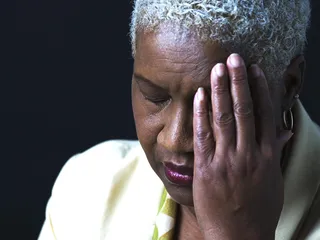The 411 on Alzheimer’s Disease
Learn more about this deadly aging illness.

1 / 12
Understanding This Disease - Recently, news hit that restaurant owner and former model B. Smith has been suffering from Alzheimer’s disease for the past four years. Read more about how this debilitating disease affects Black seniors, treatment options and signs to look for. —Kellee Terrell

2 / 12
A Deadly Brain Disease - Alzheimer’s is an irreversible, deadly progressive brain disease that gradually destroys memory and thinking skills. Over time, it breaks downs one’s ability to carry out everyday tasks such as bathing, using the bathroom, getting dressed and even remembering loved ones. The body also forgets how to function as well. (Photo: EUTERS/Laszlo Balogh)

3 / 12
What Age Does It Usually Appear? - Typically, seniors begin showing signs of Alzheimer’s around 60 years old or older. Yet, some can show signs in their mid to late 50s, like B. Smith did. She told CBS News that her symptoms began showing in her 50s. (Photo: Getty Images/Blend Images)

4 / 12
How Common Is Alzheimer’s? - The Alzheimer’s Organization estimates that in 2014, 5.2 million Americans have Alzheimer's disease. Also, approximately 200,000 people younger than age 65 have younger-onset Alzheimer's. And two-thirds of people with this disease are women. (Photo: Cavan Images/Getty Images)

5 / 12
Alzheimer’s Is Deadly - Alzheimer’s, which has no cure, is fatal. The time from diagnosis to death varies — as little as three or four years if the person is older than 80 when diagnosed to as long as 10 or more years if the person is younger.(Photo: Izabela Habur/Getty Images)
ADVERTISEMENT

6 / 12
African-Americans and Alzheimer’s - African-Americans are two times more likely to develop late-onset Alzheimer's disease than whites and more likely to be diagnosed late, resulting in less time for treatment and planning. (Photo: Jose Luis Pelaez Inc/Getty Images)

7 / 12
Your Brain on Alzheimer’s - With this disease, brain damage is beginning almost a decade before diagnosis showing no real signs. Abnormal proteins begin forming in the brain, making it hard for the nerves to work properly. This build up accumulates over time. (Photo: ZEPHYR/SPL/Getty Images)

8 / 12
Who’s at Risk? - Risk factors include: anyone over the age of 65 (every five years the risk doubles), a family history of the disease, carriers of a certain gene associated with the disease, gender (woman are more prone to Alzheimer’s), and being obese is linked as well. (Photo: Hero Images/Getty Images)

9 / 12
Do You Know the Signs? - Most people confuse Alzheimer’s with regular aging, but the two are not the same. Early signs include not remembering your name, not remembering an entire experience, poor judgment, won’t want to go to unfamiliar places, mood swings, and depression.(Photo: Jeremy Woodhouse/Blend Images/Corbis)
Photo By Photo: Jeremy Woodhouse/Blend Images/Corbis

10 / 12
Possible Treatment Options - There is no cure for Alzheimer’s, but there is treatment that can help slow down its progression. A person with this disease should be seeing a doctor every six months along with having a caretaker for when their symptoms get really bad. (Photo: JGI/Tom Grill/Getty Images)
ADVERTISEMENT

11 / 12
Alzheimer’s Prevention - There is no real approved way to prevent this disease, but the National Institute on Aging believes that there are things you can do to reduce your risk. Playing mental games, eat healthy, maintain a healthy weight, stop smoking, exercise regularly and treat your depression. (Photo: Ariel Skelley/Blend Images/Corbis)
